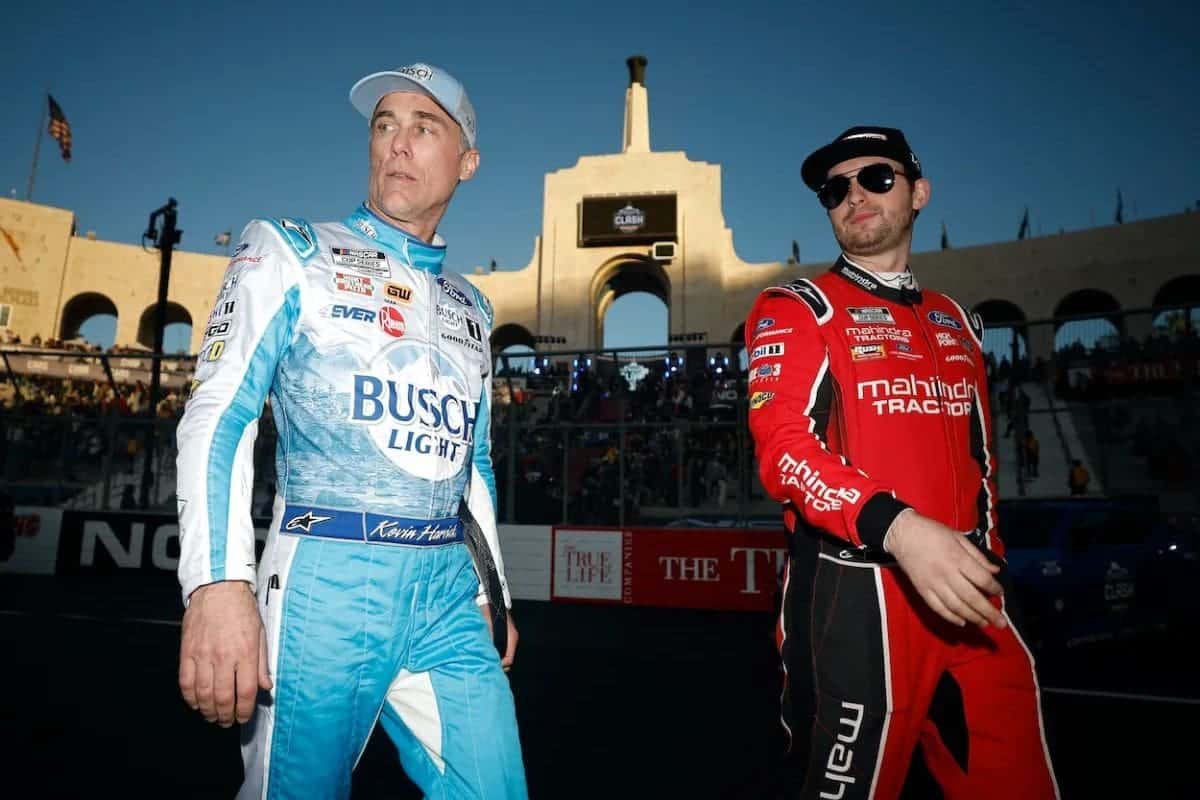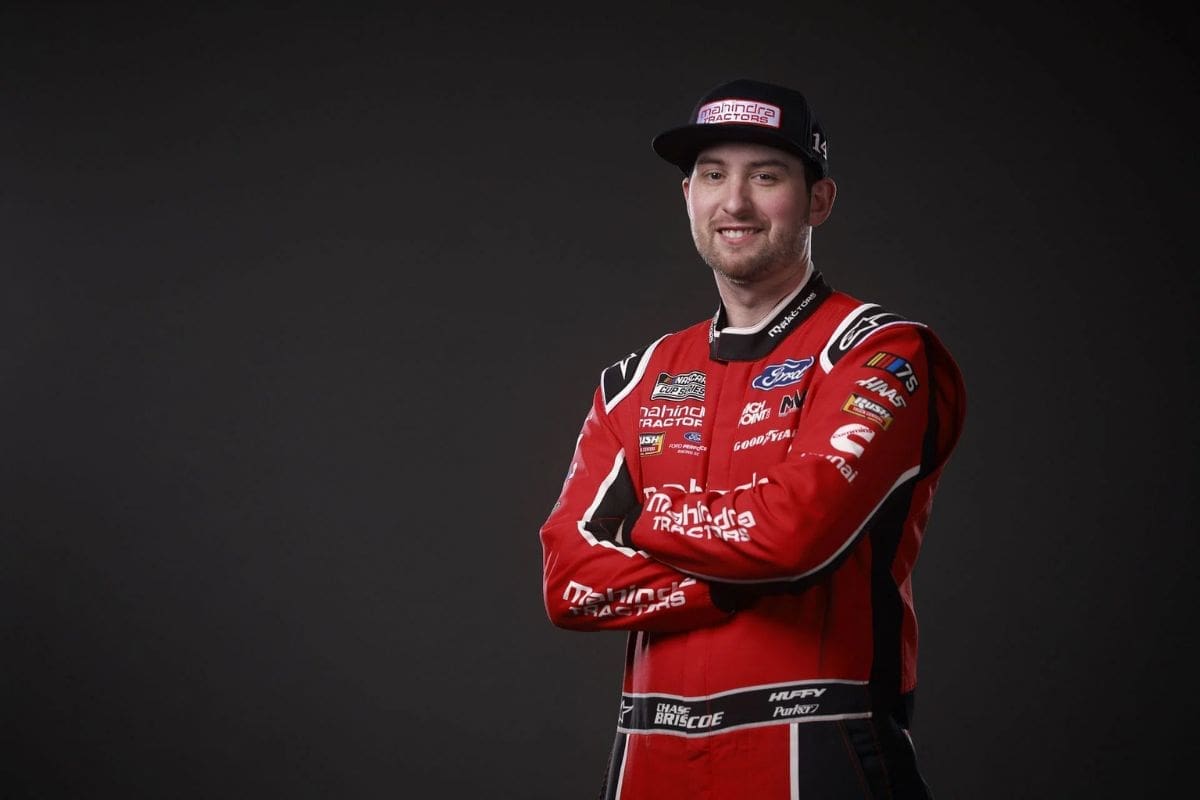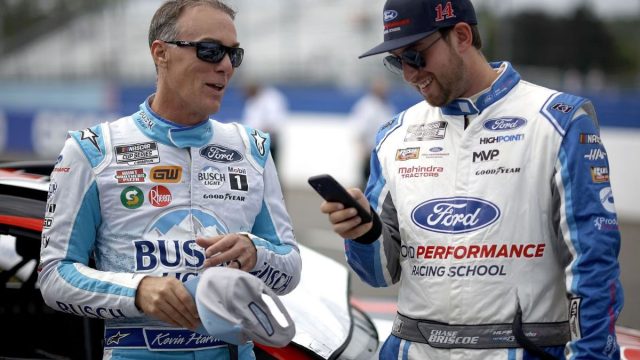Chase Briscoe Reveals Impact of Harvick’s Departure: Chase Briscoe’s insights into Kevin Harvick’s retirement from Stewart-Haas Racing (SHR) highlight a period of significant change and challenge within the team. Briscoe, stepping up in a newly evolved leadership role, underscores the internal dynamics shift, pointing towards a vacuum in guidance and morale post-Harvick. This change is prompting a necessary restructuring in SHR’s operations, moving from individualized efforts to a more unified, strategy-driven approach. The emergence of Briscoe as a pivotal figure suggests a strategic pivot and potential for resilience amidst uncertainty. His evolution within the team not only signals an adjustment to the departure but also paves a path for collective adaptation and growth, suggesting intriguing developments ahead for SHR’s strategy and performance.
Key Takeaways
- Harvick’s retirement has led to a leadership vacuum within Stewart-Haas Racing (SHR).
- Chase Briscoe is stepping up to fill the leadership void left by Harvick’s departure.
- The team faces an identity crisis and strategic shifts in the post-Harick era.
- Briscoe’s confidence showcases a potential positive turn in SHR’s internal dynamics.
- SHR is undergoing restructuring to foster unity and collaboration amidst the changes.
Chase Briscoe’s Current Performance and Team Dynamics
Chase Briscoe’s tenure in the No. 14 Ford Mustang, currently positioned 17th in the Cup Series Standings, reveals a trajectory of gradual improvement within the team dynamics post-Kevin Harvick’s departure. Observing his performance, it becomes apparent that Briscoe’s approach to racing has evolved, showcasing a deeper understanding of vehicle mechanics and strategic race planning. This insight is vital for dissecting the nuanced shift within Stewart-Haas Racing (SHR) as it maneuvers through the post-Harvick era, a period marked by significant adjustment and recalibration.
Briscoe’s improvement, although steady, suggests a meticulous assimilation of feedback and adaptation to the competitive NASCAR landscape. His ability to leverage data and insights from the team’s engineering core highlights a symbiotic relationship that is gradually fortifying. This progression is indicative of an emerging leadership role within the team, signaling a potential pivot point for SHR’s strategic direction and performance metrics moving forward.
Moreover, the fine understanding of racecraft Briscoe displays, coupled with an analytical approach to race day decisions, underscores a growing confidence. This confidence, born out of a deeper integration with the team’s dynamics, is crucial for negotiating the challenges inherent in the highly competitive nature of the Cup Series. It also reflects a broader trend within SHR to cultivate a resilient and adaptable racing strategy, one that can withstand the pressures of high-stakes competition and the inevitable comparisons to the team’s illustrious past.
In essence, Chase Briscoe’s evolving role within Stewart-Haas Racing is emblematic of a team in transformation, yet steadily forging a new identity and competitive edge in the post-Harvick landscape.

Impact of Kevin Harvick’s Retirement on SHR
With Kevin Harvick’s retirement marking a significant turning point for Stewart-Haas Racing, the team’s internal dynamics and overall morale have undergone a noticeable transformation. The departure of Harvick, a seasoned veteran and cornerstone of the team, alongside Aric Almirola, another experienced racer, has precipitated a shift within the organization that extends beyond the track.
Chase Briscoe’s insights into the current state of affairs at Stewart-Haas Racing shed light on the profound impact of these departures. The alteration in shop morale, as noted by Briscoe, signifies a critical juncture for the team as it grapples with the void left by Harvick’s retirement.
The change in the team’s dynamics is not merely about replacing a driver; it’s about the loss of leadership, experience, and a certain ethos that Harvick embodied. His retirement has forced the team to confront its identity in the wake of losing a pivotal figure who not only contributed to its successes on the track but also played a significant role in mentoring younger drivers and shaping the team culture. The departure of Almirola alongside Harvick compounds this challenge, leaving a gap in the team’s collective experience and leadership.
The impact of these changes is multifaceted, influencing not just the morale but also how the team approaches races, strategizes, and cultivates talent. In a sport where experience and mentorship are invaluable, the absence of figures like Harvick necessitates a reevaluation of roles within the team and calls for emerging leaders to step forward. As Stewart-Haas Racing navigates this transitional period, the implications of Harvick’s retirement extend far beyond the immediate concerns of filling his seat, heralding a period of adjustment and recalibration for the entire organization.
Changes and Adaptations within SHR
Stewart-Haas Racing’s adjustment to the post-Harvick era involves a thorough restructuring of its operational framework, fostering unprecedented levels of collaboration and unity across all team divisions. This significant transformation reflects a strategic pivot designed to not only address the immediate vacuum left by Kevin Harvick’s departure but also to strengthen the team’s competitive edge in the long term. Briscoe’s insights into the evolving scenario underscore a deliberate shift towards a more integrated and cohesive unit, highlighting a departure from previously stored operations.
The adjustments in processes and structural realignments within Stewart-Haas Racing can be succinctly demonstrated through the following table, which encapsulates the core areas of change and adaptation:
| Aspect | Pre-Departure | Post-Departure |
|---|---|---|
| Team Dynamics | Individualized Efforts | Unified Collaboration |
| Operational Framework | Siloed Divisions | Integrated Processes |
| Strategy Formulation | Driver-Centric | Team-Centric |
| Communication | Sequential | Cross-Functional |
| Performance Metrics | Individual Achievements | Collective Success |
These changes, as highlighted by Briscoe, are not merely reactive but indicative of Stewart-Haas Racing’s proactive approach to leveraging collective strengths. The shift towards a more unified team dynamic, with an emphasis on integrated processes and cross-functional communication, marks a pivotal change in the team’s operational ethos. This evolution, driven by the necessity to adapt in the wake of Harvick’s departure, is poised to redefine the team’s competitive strategy and operational efficiency, ensuring resilience and adaptability in the face of the sport’s ever-changing landscape.
Briscoe’s Role and Confidence
Briscoe’s newfound confidence in his leadership role marks a significant evolution in Stewart-Haas Racing’s team dynamics, reflecting a pivotal shift towards leveraging individual strengths for collective success. The departure of seasoned veterans like Kevin Harvick and Aric Almirola has reshaped the landscape within SHR, propelling Briscoe into a more pronounced leadership position. At 29, the Indiana native finds himself at a critical juncture, not just regarding his career trajectory but also in the broader context of his team’s competitive aspirations.
Briscoe’s assertion of confidence is not just about self-assurance but signals a deeper transformation within SHR. His willingness to step up and voice his opinions more forcefully suggests a maturity and readiness to shoulder greater responsibility. This change is emblematic of the natural cycle of leadership renewal that competitive sports teams undergo, yet it also highlights Briscoe’s unique position to influence the team’s direction and ethos.
His role, as he navigates these waters, is twofold. To begin with, it involves the integration of his individual performance ambitions with the collective goals of SHR. Next, it demands the cultivation of a supportive environment where the melding of experience and new talent can thrive. Briscoe’s confidence, therefore, is not just in his capabilities as a driver but in his vision for the team’s future—a future where his leadership catalyzes a new era of success for Stewart-Haas Racing. This analytical perspective on Briscoe’s role underscores the intricate balance between personal growth and team evolution, a dynamic that will without a doubt shape SHR’s trajectory in the seasons to come.

News in Brief
The departure of Kevin Harvick from Stewart-Haas Racing has unquestionably sparked a period of transformation and reassessment within the team. This event has notably impacted team dynamics, requiring adjustments and adaptations.
Chase Briscoe’s role within the team has evolved, demonstrating a need for stability and leadership in the aftermath of Harvick’s retirement. Through this period of change, Briscoe’s confidence and performance have become crucial factors in the team’s effort to navigate through the ensuing challenges and maintain competitive momentum.
Our Reader’s Queries
Q: Is Chase Briscoe a good Nascar driver?
A: In 2021, he secured a sixth-place finish, but the team faced challenges with speed last year. Now leading Stewart-Haas Racing, the 29-year-old driver anticipates that the new aero package could positively impact this weekend’s racing.
Q: Who drives for Chase Briscoe?
A: Chase Briscoe is set to revive his 410 sprint car team, Chase Briscoe Racing, this year. He revealed on Friday that driving responsibilities for the No. 5 sprint car will be shared between himself and midget driver Karter Sarff.
Q: How many Nascar wins does Chase Briscoe have?
A:Briscoe, formerly piloting the No. 98 Ford in the NASCAR Xfinity Series, clinched his ninth Xfinity race win in 2020 at Kansas Speedway, marking his 11th career victory in the series. His maiden Xfinity triumph occurred at the Charlotte Motor Speedway Roval in 2018.
Q:How long has Chase Briscoe been racing?
A:Briscoe debuted in racing in 2001, racing a quarter midget. He clinched victory in his first heat race and later triumphed in the feature event on the same day. Progressing to mini sprints, he transitioned to a 410 sprint car at 13, securing a commendable 10th place in a 40-car field in his inaugural race.
Also Read: Chase Briscoe Emerges as Stewart-Haas Racing’s New Leader

